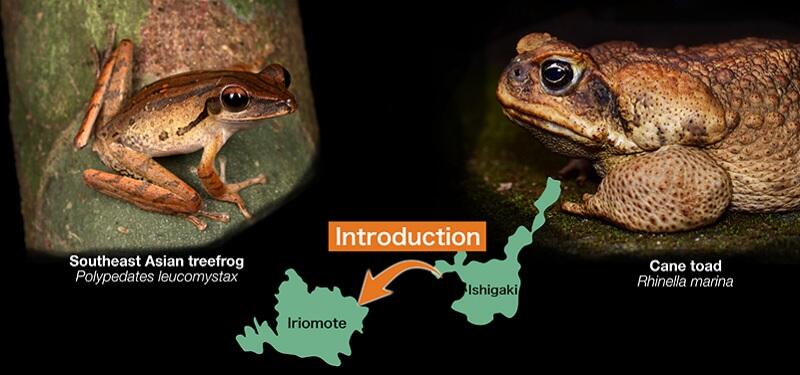A research group consisting of Doctoral Student Kaede Kimura of the Graduate School of Science at Kyoto University; JSPS Postdoctoral Fellow Ibuki Fukuyama at the Field Science Center for Northern Biosphere at Hokkaido University (Doctoral student of the Graduate School of Human and Environmental Studies at Kyoto University at the time of the research); and Professor Emeritus Kinji Fukuyama of Keio University has developed an AI model that automatically detects the cane toad (Rhinella marina) and the Southeast Asian tree frog (Polypedates leucomystax), invasive species with high risk of establishment on Iriomote Island, through their vocalizations. To test its performance, they played frog calls through speakers across various seasons throughout the year and confirmed that the AI model could detect these calls almost perfectly even amidst diverse background noise. Their findings were published in Biological Invasions.

(Photography: Ibuki Fukuyama, Kaede Kimura)
Provided by Kyoto University
Iriomote Island in Okinawa Prefecture is home to valuable endemic flora and fauna, including the Iriomote cat (Prionailurus bengalensis iriomotensis), and is registered as a Natural World Heritage site. On Ishigaki Island, located about 30 kilometers from Iriomote, cane toads (native to South America) and Southeast Asian tree frogs (native to Southeast Asia) have been increasing in number, and their invasion into Iriomote has been confirmed more than 10 times. These are highly invasive species; the cane toad is listed among the world's 100 worst invasive alien species, while the Southeast Asian tree frog is on Japan's list of 100 worst invasive alien species. The cane toad is particularly problematic as it not only preys on native insects and small animals but also possesses powerful toxins that can fatally poison larger native animals that eat them. Although establishment has not been confirmed due to eradication efforts following each detection, continued vigilance is necessary.
The research group developed a model to automatically detect invasive frog calls by repurposing BirdNET, a deep learning model originally used for bird research. In natural environments, the model was able to detect invasive species' calls on most days when calls were played through speakers. The only case where detection completely failed was on December 28, when the Southeast Asian tree frog was not detected, though the cane toad was correctly identified. Upon examining the audio data from that day, it appeared that the Southeast Asian tree frog calls were drowned out by a nighttime chorus of the native Yaeyama Tokyo daruma pond frog (Yaeyama Narrow-mouthed toad), which has similar call frequencies. Furthermore, by analyzing recordings from Ishigaki Island, where these species are already established, over a one-year period, the breeding seasons of the two frog species were clarified, revealing effective seasons for acoustic monitoring. The Southeast Asian tree frog calls from spring to autumn (February to November), while the cane toad's breeding period is not concentrated in specific seasons, with active calling recorded in spring, late summer, or winter depending on the recording location. When conducting acoustic monitoring to detect an invasion at an early phase, recordings should be conducted from spring to autumn if targeting the Southeast Asian tree frog, and year-round if the cane toad is included as a target species. Using the developed model may enable more efficient monitoring of cane toad and Southeast Asian tree frog invasions than previous methods.
Kimura commented, "We usually research amphibian ecology in the field, and we started this research to apply the knowledge and techniques we've developed from field research to contribute to the invasive species problem. During our survey on a spring night on Iriomote Island, we found rice paddies with more frogs than we had ever seen before, along with numerous snakes that came to feed on them, and we were overwhelmed by their density. We hope that such environments will remain in the future."
Journal Information
Publication: Biological Invasions
Title: Deep learning-based detector of invasive alien frogs, Polypedates leucomystax and Rhinella marina, on an island at invasion front
DOI: 10.1007/s10530-025-03553-0
This article has been translated by JST with permission from The Science News Ltd. (https://sci-news.co.jp/). Unauthorized reproduction of the article and photographs is prohibited.




